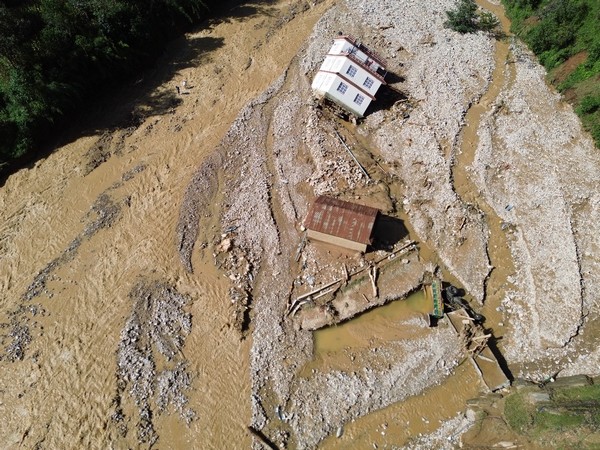Kavrepalanchowk [Nepal], October 2 (ANI): Cut off from the outside world since last week after roads and electricity infrastructure were swept away, locals in Panauti Municipality, Nepal’s Kavrepalanchowk, face a bleak future. Most houses have been toppled by the gushing waters of the Roshi River, which continues to roar.
The death toll from the rain-induced disaster, which began last Saturday, has risen to 241, with 29 still missing, according to the Armed Police Force (APF).
“We couldn’t harvest the paddy even though it had ripened. We have been forced out of our homes. Those whose houses and fields remain intact don’t have to worry about aid, but those who have lost their main source of food and shelter must rely on donors to survive. These people need support, considering their circumstances,” said Parbati KC, a displaced resident of Bhumidanda in Kavrepalanchowk District, speaking to ANI.
Heavy rainfall since September 26 caused widespread floods and landslides, which swept through Parbati’s paddy field and inundated her house, forcing her family to flee for their lives. She has since returned to her home, salvaging what she can from the debris.
Not everyone has been as fortunate as Parbati. About 5 km from Bhumidanda, Sarita Dahal of Chhaptole has lost everything.
“I lost two buffaloes, two cows, eight he-goats, and seven goats. All were swept away by the floods. Everything in the house was also washed away, except for the clothes we were wearing that night. Now, we have nothing left to lose; there’s nothing more we can bear,” Dahal shared her grief with ANI.
“We haven’t received any relief support yet,” she added.
The Roshi River burst its banks in the last week of September after torrential rains, causing the disaster that claimed at least 20 lives in Panauti alone. Over 500 houses were completely destroyed, with 713 partially damaged.
The disaster also claimed more than 2,000 livestock, and hundreds of acres of land ready for harvest were wiped out. Paddy fields have now turned into barren land, filled with boulders and stones.
“Where paddy, maize, and potatoes were once cultivated, the river has now burst its banks and toppled houses,” said Rupak Shrestha, a displaced resident of Bhumidanda, while looking over what was once his favourite place to take photographs.
The disaster, which hit just before the Dashain festival, has displaced hundreds of families from their ancestral homes.
“We are now sheltering on higher ground as our homes are unsafe. Most families have migrated because they have nowhere to live. Their homes, food, and even cattle have all been swept away,” Shrestha added.
Panauti, an ancient city in Nepal, lies about 33km from the capital, Kathmandu, but has been largely ignored by the central government.
Nepal’s weather forecasting division issued a “red alert” for 56 of the country’s 77 districts earlier last week, following the activation of monsoon winds influenced by water vapour from the Bay of Bengal and a low-pressure system.
Locals living along the Roshi River believe the disaster is the result of both climate change and haphazard stone mining from the nearby hills.
“The elders in the village say they’ve never seen such extreme weather before. In 1981, there was heavy rainfall for three hours in the morning, but it receded by the afternoon. This time, the rain lasted much longer and caused devastation,” said Laxmi Khatri, another displaced resident, speaking to ANI.
“The stone mine uphill contributed to this disaster. The gravel collected there, along with the forest, was washed away, destroying our properties,” Khatri added.
According to the hydrology department’s readings on September 28, three weather stations in Kavrepalanchowk recorded record-high rainfall. Khopasi weather station recorded 331.6mm, Panchkhal recorded 232.5mm, and Dhulikhel recorded 224.6mm of rain.
On the same day, 22 other weather stations across Nepal also recorded record rainfall, despite earlier projections that the country would receive above-average rainfall this year.
“The stone mines can also be considered a factor in the disaster. Climate change plays a role in these incidents. Heavy rain and overflowing springs in the forest have been the primary causes,” said Jayram KC, Chairman of Panauti Municipality Ward 12.
“Both entry points to the ward were blocked by landslides, making movement within the ward impossible. We prioritised rescuing the injured and managing the dead. From today (Tuesday), we are focusing on distributing relief materials,” KC added.
Nepal, home to nine of the world’s ten highest peaks, had already anticipated above-average rainfall this year, with 1.8 million people expected to be affected. The National Disaster Risk Reduction and Management Authority (NDRRMA) estimated that 412,000 households would be impacted by monsoon-related disasters.
The monsoon season in Nepal typically begins on June 13, with its end date traditionally being September 23. However, this year, the monsoon has been extended into late October. The clouds from the south entered Nepal from the western region on June 10, three days ahead of the usual onset. Last year, the phenomenon began on June 14, a day after the usual start date.
The monsoon, which delivers around 80 per cent of Nepal’s annual rainfall, generally lasts for 105 days. However, in recent years, the withdrawal has taken longer. This season, Nepal has already recorded above-average rainfall.
According to the Meteorological Office, the country had received 1,586.3mm of rainfall as of Friday morning, 7.2 per cent above the average monsoon total.
Typically, Nepal receives an average of 1,472 mm of rain during the four months of June, July, August, and September. Last year, the country recorded only 1,303mm, 88.5 per cent of the average. (ANI)
Disclaimer: This story is auto-generated from a syndicated feed of ANI; only the image & headline may have been reworked by News Services Division of World News Network Inc Ltd and Palghar News and Pune News and World News
HINDI, MARATHI, GUJARATI, TAMIL, TELUGU, BENGALI, KANNADA, ORIYA, PUNJABI, URDU, MALAYALAM
For more details and packages
















